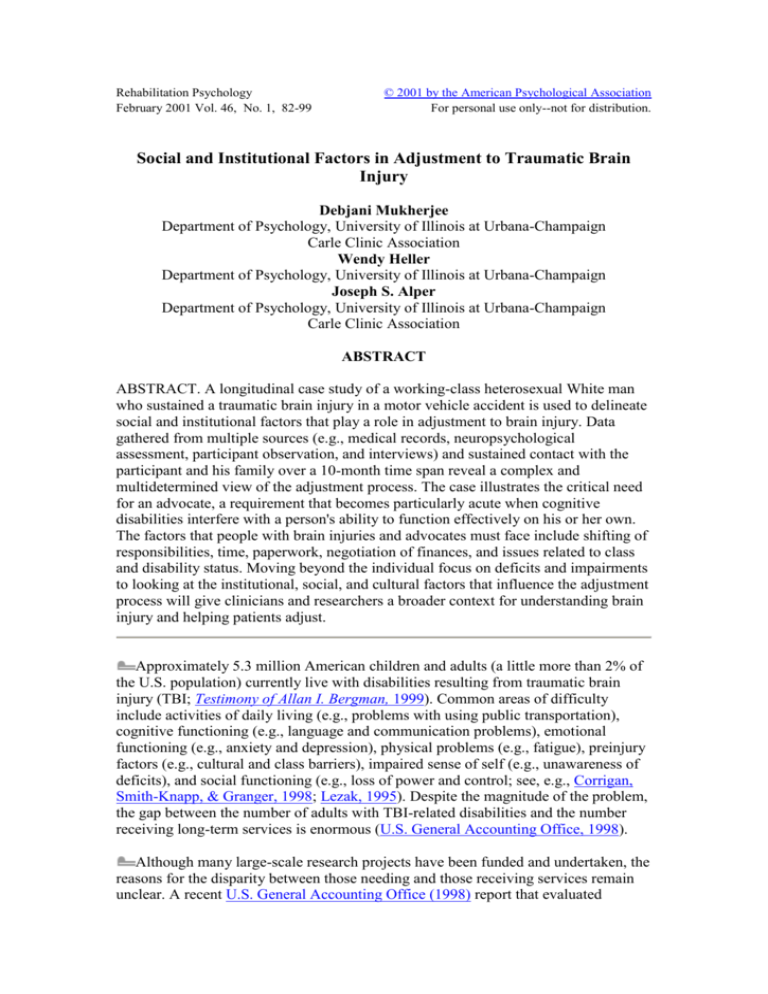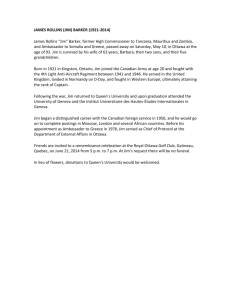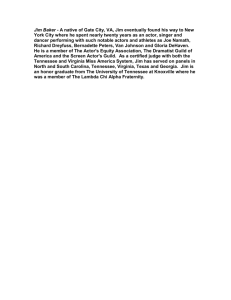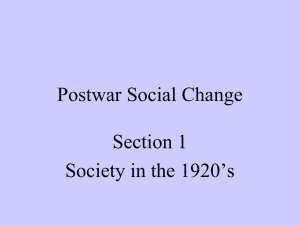Social and Institutional Factors in Adjustment to Traumatic Brain Injury
advertisement

Rehabilitation Psychology February 2001 Vol. 46, No. 1, 82-99 © 2001 by the American Psychological Association For personal use only--not for distribution. Social and Institutional Factors in Adjustment to Traumatic Brain Injury Debjani Mukherjee Department of Psychology, University of Illinois at Urbana-Champaign Carle Clinic Association Wendy Heller Department of Psychology, University of Illinois at Urbana-Champaign Joseph S. Alper Department of Psychology, University of Illinois at Urbana-Champaign Carle Clinic Association ABSTRACT ABSTRACT. A longitudinal case study of a working-class heterosexual White man who sustained a traumatic brain injury in a motor vehicle accident is used to delineate social and institutional factors that play a role in adjustment to brain injury. Data gathered from multiple sources (e.g., medical records, neuropsychological assessment, participant observation, and interviews) and sustained contact with the participant and his family over a 10-month time span reveal a complex and multidetermined view of the adjustment process. The case illustrates the critical need for an advocate, a requirement that becomes particularly acute when cognitive disabilities interfere with a person's ability to function effectively on his or her own. The factors that people with brain injuries and advocates must face include shifting of responsibilities, time, paperwork, negotiation of finances, and issues related to class and disability status. Moving beyond the individual focus on deficits and impairments to looking at the institutional, social, and cultural factors that influence the adjustment process will give clinicians and researchers a broader context for understanding brain injury and helping patients adjust. Approximately 5.3 million American children and adults (a little more than 2% of the U.S. population) currently live with disabilities resulting from traumatic brain injury (TBI; Testimony of Allan I. Bergman, 1999). Common areas of difficulty include activities of daily living (e.g., problems with using public transportation), cognitive functioning (e.g., language and communication problems), emotional functioning (e.g., anxiety and depression), physical problems (e.g., fatigue), preinjury factors (e.g., cultural and class barriers), impaired sense of self (e.g., unawareness of deficits), and social functioning (e.g., loss of power and control; see, e.g., Corrigan, Smith-Knapp, & Granger, 1998; Lezak, 1995). Despite the magnitude of the problem, the gap between the number of adults with TBI-related disabilities and the number receiving long-term services is enormous (U.S. General Accounting Office, 1998). Although many large-scale research projects have been funded and undertaken, the reasons for the disparity between those needing and those receiving services remain unclear. A recent U.S. General Accounting Office (1998) report that evaluated postacute services for individuals with TBI suggested that two major factors limiting access to services are the existence of a cognitive impairment in the absence of a physical disability and the lack of an effective advocate to negotiate the social service system. These data suggest that the majority of previous research, which has focused on individual factors couched in terms of deficits and impairments, may have overlooked the importance of the social and cultural climate in which the brain injury is experienced and the adjustment process occurs. In this article, we use an exemplar case of a working-class heterosexual White man who sustained a TBI in a motor vehicle accident to delineate social and institutional factors that play a role in adjustment to brain injury. Although the current research is within the domain of the case study tradition, it differs from most clinical reports in that the research was framed and approached from a cultural psychology perspective (e.g., Cole, 1990; Shweder, 1990; Shweder & Sullivan, 1993). Cultural psychology “is the study of the way cultural traditions and social practices regulate, express, transform, and permute the human psyche” (Shweder, 1990, p. 1). Culture is viewed as emergent, dynamic, and continually negotiated. Cultural psychologists are skeptical about presupposed distinctions between individual and environment and assume that a person and a system are interdependent and, in fact, that persons and systems are coconstructed. For a rehabilitation psychologist with a cultural psychology perspective, this might mean that a patient's recovery has to be examined as a process (in addition to gathering outcome variables such as return to work), that the interdependence of person and culture has to be recognized and explicated (in addition to documenting cognitive impairments caused by the brain injury), and that the perspectives of the patient and family members have to be given voice and importance (in addition to the perspectives of health care practitioners and legislators). In keeping with this orientation, rehabilitation psychologists would not simply view culture as a variable that must be accounted for but would examine the cultural contexts in which brain injury is experienced. The case discussed in this article is part of a larger study examining posthospital recovery from brain injury. In this case, Debjani Mukherjee followed the patient for 10 months. She had contact with him and his family while he was in the intensive care unit, was his psychometrist while he was an inpatient and outpatient, and assessed and interviewed him and his sister several weeks after he was discharged and again 6 months later. She also interviewed his sister 2 months after the second research session and had periodic telephone contact with her throughout the time period. She interacted with the patient in four settings—intensive care unit, hospital unit, neuropsychologist's office, and sister's home—although the most extensive contact was in his sister's home (for a discussion about the importance of place, see Feld & Basso, 1996). Quantitative (e.g., neuropsychological assessment measures) data were gathered, and open-ended interviews were conducted (see the Appendix for the measures administered). The participants were viewed as collaborators, and the content of the interviews was in large part dictated by the areas that they spontaneously brought up or elaborated on. Although rehabilitation staff typically approach work with patients on a case-bycase basis and have sustained contact with them, research is typically conducted on groups of patients assessed with forced-choice questionnaires and performance measures. The present discussion of one patient, followed for a year and assessed at different points in time using multiple methods, allows for an in-depth contextual understanding of the complexities of negotiating the adjustment to brain injury and is consistent with the ways in which rehabilitation is practiced if not typically researched. CASE STUDY The Injury Jim (all names are pseudonyms), a 43-year-old working-class heterosexual White man with a 12th-grade education, was an unrestrained driver in a head-on automobile collision. Before the accident, he had worked as a temporary machinist. He had lived near his seven siblings and parents in a midwestern city but was on his way to Florida with his girlfriend to “start over” when he had the accident. Brain trauma was evident to emergency personnel, who observed some brain matter coming out of his nostrils. Jim was intubated, and by the time he arrived at the trauma center he scored a 3 on the Glasgow Coma Scale (Jennet & Bond, 1975), indicating a severe lack of response to stimuli. Computed tomography of his head showed a depressed skull fracture with intraparenchymal hemorrhage and subdural hematoma with multiple fractures. By the time Jim was discharged, he had undergone numerous hospital procedures including elevation of the depressed skull fracture (the day he was admitted) and a right frontal craniotomy. On numerous assessment measures over time, Jim showed impairments in tests sensitive to right hemisphere and frontal lobe function (consistent with surgical resectioning of his right frontal lobe). In addition to processing visuospatial information, the right hemisphere has been shown to be important in understanding the emotional meaning of nonverbal communication, such as facial expression, voice prosody (intonation, pitch, and emotional expression), and gestures (e.g., Borod, 1993; Bowers, Bauer, & Heilman, 1993). Moreover, individuals with right hemisphere brain damage may feel disconnected or have difficulty negotiating social situations, may have difficulty taking another's perspective, and may display inappropriate affect (e.g., Lezak, 1995). Self-awareness may also be impaired, and patients may be unaware of deficits (anosognosia; e.g., Prigatano & Schacter, 1991). Furthermore, emerging research on right hemisphere functioning and psychopathology (e.g., depression and anxiety) suggests that we have only limited knowledge about the complexity of right hemisphere functioning and its role in emotion, emotional disorders, and well-being (see Heller, 1997; Heller, Etienne, & Miller, 1995; Heller & Nitschke, 1997). Jim also showed impairments in frontal lobe function. Frontal regions are involved in executive functions such as planning, initiation of behavior, purposive action, selfregulation, judgment, assimilation of new information, and adaptation to novel situations (for a review, see Banich, 1997). Damage to the frontal lobes can result in social disinhibition, apathy, anergia, impaired cognitive estimation, and diminished awareness of deficits (e.g., Levin, Eisenberg, & Benton, 1991). Patients with frontal lobe damage also tend to perseverate or engage in repetitive behavior or inappropriate continuation of a response. For example, perseveration could take the form of repeating a word or sentence, writing three or four o's in the word soon, or being unable to stop an activity such as watching television. Finally, the frontal lobes appear to be instrumental in emotional regulation or the ability to moderate or control emotions. In essence, frontal lobe dysfunction tends to have effects throughout the behavioral repertoire (e.g., Stuss & Gow, 1992). In sum, we might expect in the social domain that an individual with diffuse right hemisphere and frontal lobe injury could have problems with (a) social skills such as turn taking in a conversation (cued by facial expression and voice prosody), responding appropriately to emotional situations, and showing appropriate affect; (b) communication skills such as organizing information coherently, not perseverating on one aspect of a story, and expressing emotion; and (c) visuospatial skills such as the ability to drive, the ability to follow directions to a new location (such as a friend's house), and the negotiation of living space. Furthermore, the realities of living in U.S. society as a person with a disability and limitations in the cognitive, emotional, physical, and social domains, combined with organic damage to specific areas of the brain, may lead to depression and anxiety (e.g., Elsass & Kinsella, 1987; Heller, 1997; Lezak, 1995). The Adjustment Process Expectations about recovery are often set in the hospital. Jim made rapid progress once he was moved from the intensive care unit to the surgical inpatient unit. It was surprising that, within days, he was walking and able to carry on conversations about what he did before he was hospitalized. Jim's family became very hopeful that he might eventually be back to “normal” and that his recovery would continue at the rapid pace observed on the inpatient (non-critical-care) unit. Unfortunately, because being able to walk and talk are obvious indications of improvement, sometimes the more subtle “deficits” are minimized or overlooked. Jim was discharged to outpatient rehabilitation 20 days after he was admitted. He returned to the trauma hospital 5 days later complaining of severe headaches. He was diagnosed with multiple abscesses, probably caused by a staph infection that he had been treated for when his intracranial pressure monitor was removed. When I asked Jim's sister Gina why they had driven 150 miles for care that they could have received in the large city near which they lived, she stated that Jim did not have medical insurance and that it was easier to drive 3 hr to ensure he would receive good medical care. Jim's clinical presentation as an outpatient and during the first and second research sessions has been documented in detail elsewhere (Mukherjee, 1998; see Appendix for measures administered). Results from the outpatient neuropsychological evaluation suggested severe impairments across a number of domains. It was likely that Jim would have difficulties with navigating space, solving problems, adapting to novel situations or thinking flexibly, and interpreting and communicating social and emotional information. The first research contact was the week after Jim's outpatient neuropsychological evaluation. Briefly, Jim was impaired on measures of language and memory functioning. He was not depressed or anxious (as assessed by standardized measures) and believed that his quality of life was good. However, the research process underscored the limitations of assessing emotional functioning in individuals with brain injuries using forced-choice questionnaires. For example, on the Beck Depression Inventory (Beck, 1987), Jim had the following 0-point responses: “I do not feel sad,” “I get as much satisfaction out of things as I used to,” and “I can work about as well as before.” Yet, at points during the interview, he reported that he was in fact sad, that he wished he could go back to work and this bothered him, and that he was frustrated. The second research contact took place 6 months later. Jim's clinical presentation was slightly improved, although his performance on standardized neuropsychological assessment measures was uneven (he scored higher on some tests and lower on others). He continued to show severe impairments on measures of visual and perceptual functioning and language production. His responses on measures of social and emotional functioning indicated that he was feeling worse than he had felt 6 months earlier. In my field notes, it was noted that Jim looked much healthier and was more engaged during the assessment. Emotionally, however, it was as if the reality of his situation had set in and the routines of his daily life had not improved in the ways that he and Gina had hoped. Financial and bureaucratic obstacles were also causing distress. Jim and Gina were worried about how Jim would be able to make ends meet, which medical providers would accept his “medical card,” and whether Jim would ever be able to be “independent” enough to live on his own again. Need for an Advocate In a report to Congress, U.S. General Accounting Office investigators (1998) recently concluded that “people without someone to act as their personal advocate have difficulty obtaining services from multiple programs. … An adult with TBI without an effective and knowledgeable advocate would probably not receive services” (p. 14). Although the investigators acknowledged that TBI patient advocacy is very important, they did not elaborate on what advocacy requires. The present study not only illustrates the importance of an advocate but contributes to our understanding of the processes involved. One very clear pattern that emerged early in the research process was the role of Gina in Jim's adjustment to brain injury. Gina undertook a tremendous amount of work and invested remarkable emotional and physical energy. Interview data revealed that Gina's life changed drastically. She reported increased responsibilities, less time for herself, dealing with iterations of paperwork, negotiating finances for her brother, and battling with bureaucratic workers and dominant cultural assumptions about social class and disability status. Increased Responsibility As part of her role as advocate, Gina assumed responsibility for Jim. Although Gina identified herself as the “helper” or “caretaker” of her family of origin, the responsibilities that she assumed after Jim's brain injury went beyond “feeling protective” of him when they were younger (even though Jim was older than Gina) or helping him out occasionally. When he sustained the brain injury and serious decisions about medical care were being made, her parents and other siblings turned to Gina to “take over.” Because she had worked in hospital settings (most recently as an emergency room registration clerk), the rest of the family believed that she would be best qualified. By the third research session, Gina had applied for and obtained legal guardianship of Jim. She was subsequently legally responsible for Jim's financial and medical decisions. Although Jim was sometimes frustrated with Gina (and called her a “hemorrhoid” because “she is always riding my ass”), he trusted her to “make the right decisions” and “help me out.” At the time of the third research session, Gina had not told her husband that the guardianship had been approved (“He has no idea how much time I spent towards Jimmy”). Gina also felt responsible for Jim's whereabouts. On more than one occasion, Jim got lost and was not able to find his way home. In addition, Gina did not like some of Jim's friends, and, although she did not “concern herself” with how he spent his time before, she now worried about “people taking advantage of him, like they would a teenager.” Time An aspect related to increased responsibility was the time that Gina had devoted to Jim since his accident. Gina made several major changes to her routine. For example, after the accident she got a beeper “that in the need, if Jimmy has an emergency, somebody can get me.” She reported that she had no free time after his accident: “The bottom line is the little bit of free time I used to have, now Jimmy has taken the place. So Jimmy is my soap operas and my news time.” Gina worked the third shift at a hospital, and her schedule allowed her to make phone calls and drive Jim to appointments during the day. She worried about what she would do if Jimmy got really sick again. The pressure and time commitment left her exhausted and worn out. Paperwork Part of Gina's huge time commitment involved the need to fill out (literally) stacks and stacks of paperwork that had to be completed if Jim was to receive disability benefits, supplemental security income, food stamps, and Medicaid. In addition, Gina invested enormous amounts of time and energy to re-create Jim's work history, financial history, and educational and medical history (which involved contacting doctors, administrators, and social services, federal, and state agencies). She had to contact his bank and the post office (to have mail forwarded from his post office box). She had to file taxes for him in April. Gina had a large accordion folder with all of the records that she had gathered on Jim's behalf. Her telephone log, documenting only a fraction of the phone calls that she had made to various agencies, was many pages in itself. Not surprisingly, a patient with a brain injury that interfered with planning, organization, initiation, and follow-through would have great difficulty wading through the “paper mess.” Negotiation of Finances Another critical role of the advocate was in the negotiation of finances. Financial problems were a huge barrier to recovery for Jim. Jim was initially denied disability benefits, and Gina called a state representative (as suggested by a lawyer whose advertisement she saw on television); what was “caught in the red tape” was freed, and Jim was approved. In the meantime, Jim had little or no money “of his own” for several months and relied on family to support him. Even after Jim started receiving disability benefits, his income was only $550 a month. In addition, he had a “spindown” of $250 for Medicaid and had to conserve some of his income in the event it would be needed. (A spindown is the equivalent of a deductible amount on a car insurance policy; Jim had to pay the spindown amount before Medicaid would cover additional medical expenses.) Gina reported having to file three times for Medicaid before it was approved for Jim. When she called the trauma hospital to tell them that they would not get paid, they referred Gina to a private organization that helps people that they truly feel are disabled get approved. The initial denial notice from the state agency that deals with Medicaid benefits stated that Jim “did not meet departmental definitions of disabled.” Apparently, the intervention by the private organization remedied the misinformation. Note, however, that in the current system it is possible that someone with such a severe brain injury would not meet a definition of disabled. Even after the Medicaid was approved, Gina was frustrated by the inefficiency and lack of information about what to expect from the system. After fighting “tooth and nail with those dumbos,” they “never tell you point blank how much you are going to receive.” Another financial barrier was the lack of affordable housing. Again, the current political and sociocultural climate and underfunding of services for the poor affected Jim's situation. Gina reported that no applications were being taken for governmentsubsidized (Section 8) housing and that, even with someone else controlling Jim's limited income, it was impossible to find affordable housing. Gina remarked, “They have no funding this year. So now where do you go for help, you see?” Issues Related to Class and Disability Status Jim's history before the car accident contributed to the assumptions that were made about him by various professionals and agency employees. At 43 years old, he had a sporadic (“unstable”) work history and had engaged in some high-risk behaviors such as driving recklessly. He dropped out of high school and worked a series of part-time jobs, the most recent one being as a temporary worker in a factory. When he was younger, his family had been on public aid. After Jim had the accident, his social status confounded the difficulties he faced because of his TBI. Jim's experiences as a working-class person with a brain injury illustrate the degree to which pervasive stereotyping about social class influences access to resources. A less obvious dynamic is the social and emotional cost of dealing with the disrespect commonly encountered by individuals in our society whose life experiences fit societal expectations of a less valued citizen. The disrespect and conflation of class with disability status were instantiated in an interaction that Jim and Gina had with a woman who worked for “general assistance.” She asked whether other members of their family were receiving general assistance and implied that Jim was trying to make money out of the system. As Gina reported, “Don't tell me you're going to sit there and look at him, not know he has a problem, know that there's no way in God's earth that he lied to you.” The assumption that people who use social welfare services are trying to take advantage of the system was pervasive. Gina reported the “nasty lady” to her supervisor, and “that lady got in trouble.” In this example, Jim eventually received the services for which he was eligible. However, the daily hassles, the questioning of Jim and Gina's intentions, having to fight for services for which he was obviously eligible, and having negative interpersonal interactions with bureaucratic workers made Jim and Gina even more exhausted and stressed than a family with economic resources and social capital would have been in the same circumstances. Surprisingly, Gina had not met face to face with almost any of the “workers” she dealt with, and she often had to deal with automated phone systems. When she did “talk to a person,” she would often be told that she would have to be called back (but was not) or would be put on hold (more often than not). She also reported having to deal with “attitude.” Gina's battles with the bureaucracy were filled with delays and lack of easily accessible information. Gina reported that because she was familiar with the public aid system, she thought that it would be easier to figure out the social services that Jim needed. But her past experiences and knowledge of how “the system” works did not translate into knowledge of the rules for disability and social security. Furthermore, when she called to find out who was eligible for disability, she found out that “they don't even have a list of disorders. It's on a case-by-case basis. Now what if you get someone who doesn't like your case?” Another issue in Jim's adjustment process was labeling. While Gina was “digging for his paperwork,” she found out that Jim was eligible for special education services in school, and it was this label that she used to try to obtain the needed housing services. Apparently, Jim was ineligible to live in a supported living environment (or group home) because “his auto injury itself does not qualify him for nothing, no special help, nothing 'cause there's different classifications. But, when you say that he was in special ed., and they labeled him mildly disabled, then maybe.” Essentially, if Jim had the right label, then he would be able to live in a group home for individuals with developmental disabilities. If he had not had the car accident, Gina would not have even thought of him as developmentally disabled. In fact, she was surprised to read his school reports and “had no idea that Jim was reading and doing math at that level.” Persons with brain injury do not neatly fit into any of the categories for the services to which Gina has access (it may be different in other parts of the country), so finding the right label was an important way to overcome obstacles. IMPLICATIONS Data gathered from multiple sources (e.g., medical records, neuropsychological assessment, participant observation, and interview) and sustained contact with a patient and his family over a 10-month time span present a complex and multidetermined picture of adjustment to brain injury. The case illustrates the critical need for an advocate, a requirement that becomes particularly acute when cognitive disabilities interfere with a person's ability to function effectively on his or her own. In addition to the considerations described earlier (e.g., costs to the advocate and social and institutional barriers exacerbated by lower social status), the findings also speak to a number of sequelae associated with the sociocultural environment in which people with a brain injury find themselves. Loss of social autonomy is an area that is increasingly being recognized as a barrier to meaningful recovery from brain injury. Like Jim, many patients who do not need assistance in activities such as eating or dressing themselves may still be dependent on others for financial help and advice, transportation, legal assistance, and other matters. In a recent epidemiological study (Mazaux et al., 1997), investigators followed up with TBI patients 5 years after their injury to assess which neuropsychological and neurobehavioral indexes were related to loss of social autonomy (as defined in the European Brain Injury Society's European Head Injury Evaluation Chart). The social abilities that were most consistently impaired in the 5year follow-up were as follows: “performing administrative tasks and financial management, writing letters and calculating, driving, planning the week, and using public transport” (Mazaux et al., p. 1316). The concepts of autonomy and dependence are recurring themes in Western (American and European) conceptions of disability. Although being seen as dependent is often socially devalued, the concept of dependency may have different connotations and implications in different cultures (see Ingstad & Reynolds Whyte, 1995, for examples of the relationship between disability and culture). Sociocultural discourses about brain injury, impaired functioning, and limitation play into a greater cultural climate that encourages values related to independence and the ability to overcome obstacles. For example, typically (or stereotypically) in the United States, adults are expected to live separately from their parents, vocational capability is a source of status and worth, and asking for help and assistance can be seen as a sign of weakness. Class, ethnicity, sexual orientation, and gender obviously affect an individual's cultural context, and stereotypes about any of the multiple groups that people may belong to can compound and complicate ideas about independence. For example, in Jim's case, being a working-class heterosexual White man is likely to mean that he should be a “breadwinner,” or that he should not have to face as much institutional discrimination as a non-White person of the same socioeconomic class but more than a White person of a higher socioeconomic class. In sum, being seen as dependent on others is typically socially devalued in the United States. A more complex picture emerges when we look at the various contexts and categories that people occupy, but it is likely that there is stress associated with being viewed as dependent. This goes above and beyond the actual difficulties that Mazaux and colleagues (1997) mentioned when they discussed social autonomy. Dependence among people with a brain injury is further heightened by institutional barriers such as access to services, applying for and receiving governmental benefits, negotiating the transportation system, and the time and organization required to make sense of “the system.” The relationship between institutional barriers and health has been addressed with other marginalized groups such as ethnic minorities (Cummings & DeHart, 1995) and women (Koss & Woodruff, 1991), but the issues of institutional barriers to recovery from brain injury have not, to our knowledge, been articulated in the research literature. Furthermore, numerous researchers have commented on the need for consistent and reliable measures of outcomes after brain injury (e.g., Body & Campbell, 1995; Malec & Basford, 1996), and several have included measures of economic self-sufficiency and social integration as important components of outcome, yet institutional barriers to achieving these positive outcomes are not acknowledged. Many rehabilitation psychologists and clinical neuropsychologists are aware of these barriers, but the realities of living with a brain injury or other disability have been primarily articulated by activists and consumers rather than providers (e.g., Fries, 1997). For example, the Health Resource Center for Women With Disabilities at the Rehabilitation Institute of Chicago has sponsored a series of conferences on health care issues that address barriers such as the impact of managed care on access to services and quality of care (see Olson & Lee, 1996; in addition, see Gill, Kirschner, & Reis, 1994, for a refreshing perspective on the barriers faced by women with disabilities). Even the U.S. government is slowly realizing that there are substantial barriers to receiving adequate long-term services (see U.S. General Accounting Office, 1998). Finally, other issues related to disabled status must be noted. There are numerous assumptions about what being disabled means. There is a long tradition of treating individuals with some type of disability as not whole or as fundamentally flawed. Furthermore, one of the assumptions about disability discussed by Fine and Asch (1988) is the following: “When a disabled person faces problems, it is assumed that the impairment causes them” (p. 9). We acknowledge that Jim had a severe injury and has significant impairments but argue that many of his problems can be viewed as institutional barriers that exacerbate and compound his difficulties. If the focus is on the disabled person as “broken,” then we will not be likely to examine the system factors that need to be fixed. Similarly, if we treat the brain injury as solely an individual problem, then we will not be as likely to research and remediate the sociocultural factors that contribute to the adjustment process. In summary, moving beyond a focus on an individual's deficits and impairments by adopting the broader cultural psychological and rehabilitation psychological perspective on the adjustment process will give clinicians and researchers a broader context for understanding brain injury and helping patients adjust. References Banich, M. T. (1997). Neuropsychology: The neural bases of mental function. (Boston: Houghton Mifflin.) Beck, A. T. (1987). Beck Depression Inventory manual. (San Antonio, TX: Psychological Corporation.) Beck, A. T. (1990). Beck Anxiety Inventory manual. (San Antonio, TX: Psychological Corporation.) Benton, A. L.,& Hamsher, K. de S. (1978). Multilingual Aphasia Exam. (Iowa City, IA: AJA Associates.) Benton, A. L., Sivan, A. B., Hamsher, K. D. S., Varney, N. R.,& Spreen, O. (1983). Contributions to neuropsychological assessment. (New York: Oxford University Press.) Body, R.,& Campbell, M. (1995). Choosing outcome measures. (In M. A. Chamberlain, V. Neumann, & A. Tennant (Eds.), Traumatic brain injury rehabilitation: Services, treatments and outcomes (pp. 245–258). London: Chapman & Hall.) Borod, J. C. (1993). Cerebral mechanisms underlying facial, prosodic, and lexical emotional expression: A review of neuropsychological studies and methodological issues. Neuropsychology, 7, 445-463. Bowers, D., Bauer, R. M.,& Heilman, K. (1993). The nonverbal affect lexicon: Theoretical perspectives from neuropsychological studies of affect perception. Neuropsychology, 7, 433-444. Cohen, S. R., Mount, B. M., Bruere, E., Provost, M., Rowe, J.,& Tong, K. (1997). Validity of the McGill Quality of Life Questionnaire in the palliative care setting: A multi-centre Canadian study demonstrating the importance of the existential domain. Palliative Care Medicine, 11, 3-20. Cole, M. (1990). Cultural psychology: A once and future discipline. (In J. J. Berman (Ed.), Cross cultural perspective: Nebraska Symposium on Motivation, 1989 (pp. 279–335). Lincoln: University of Nebraska Press.) Corrigan, J. D., Smith-Knapp, K.,& Granger, C. V. (1998). Outcomes in the first 5 years after traumatic brain injury. Archives of Physical Medicine and Rehabilitation, 79, 298-305. Cummings, C. M.,& DeHart, D. D. (1995). Ethnic minority physical health: Issues and interventions. (In J. F. Aponte & R. Y. Rivers (Eds.), Psychological interventions and cultural diversity (pp. 234–249). Boston: Allyn & Bacon.) Elsass, L.,& Kinsella, G. (1987). Social interaction following severe closed head injury. Psychological Medicine, 17, 67-78. Feld, S.,& Basso, K. H. (1996). Senses of place. (Santa Fe, NM: School of American Research Press.) Fine, M.,& Asch, A. (1988). Disability beyond stigma: Social interaction, discrimination and activism. Journal of Social Issues, 44, 3-21. Fries, K. (1997). Staring back: The disability experience from the inside out. (New York: Plume.) Geffen, G., Hoar, K. J., O'Hanlon, A. P., Clark, C. R.,& Geffen, L. B. (1990). Performance measures of 16- to 86-year-old males and females on the Auditory Verbal Learning Test. Clinical Neuropsychologist 4, , 45-63. Gill, C., Kirschner, K.,& Reis, J. P. (1994). Health services for women with disabilities: Barriers and portals. (In A. J. Dan (Ed.), Reframing women's health: Multidisciplinary research and practice (pp. 357–367). Thousand Oaks, CA: Sage.) Goodglass, H.,& Kaplan, E. (1972). The assessment of aphasia and related disorders. (Philadelphia: Lea & Febiger.) Heaton, R. K. (1981). Wisconsin Card Sorting Test manual. (Odessa, FL: Psychological Assessment Resources.) Heller, W. (1997). Emotion. (In M. T. Banich (Ed.), Neuropsychology: The neural bases of mental function (pp. 398–429). Boston: Houghton Mifflin.) Heller, W., Arya, N.,& Mukherjee, D. (1997). Emotional and social information processing. ([Experimental assessment measure]. Available from Wendy Heller, Department of Psychology, 603 East Daniel Street, Champaign, IL 61820.) Heller, W., Etienne, M.,& Miller, G. A. (1995). Patterns of perceptual asymmetry in depression and anxiety: Implications for neuropsychological models of emotion and psychopathology. Journal of Abnormal Psychology, 104, 327-333. Heller, W.,& Nitschke, J. B. (1997). Regional brain activity in emotion: A framework for understanding cognition in depression. Cognition and Emotion, 11, 637-661. Ingstad, B.,& Reynolds Whyte, S. (1995). Disability and culture. (Berkeley: University of California Press.) Jennet, B.,& Bond, M. (1975). Assessment of outcome after severe brain damage. Lancet, 1, 480-487. Koss, M. P.,& Woodruff, W. J. (1991). Emerging issues in women's health. (In J. J. Sweet & R. H. Rozensky (Eds.), Handbook of clinical psychology in medical settings (pp. 201–222). New York: Plenum.) Levin, H. S., Eisenberg, H. M.,& Benton, A. L. (1991). Frontal lobe function and dysfunction. (New York: Oxford University Press.) Lezak, M. D. (1995). Neuropsychological assessment. (New York: Oxford University Press.) Malec, J. F.,& Basford, J. S. (1996). Postacute brain injury rehabilitation. Archives of Physical Medicine and Rehabilitation, 77, 198-207. Mazaux, J., Masson, F., Levin, H. S., Alaoui, P., Maurette, P.,& Barat, M. (1997). Long-term neuropsychological outcome and loss of social autonomy after brain injury. Archives of Physical Medicine and Rehabilitation, 78, 1316-1320. Moos, R. H.,& Moos, B. S. (1994). Life Stressors and Social Resources Inventory— Adult Form (LISRES-A), professional manual. (Odessa, FL: Psychological Assessment Resources.) Mukherjee, D. (1998). Headaches and hurdles: A case-based cultural approach to brain injury recovery. (Unpublished master's thesis, University of Illinois, UrbanaChampaign.) Olson, D.,& Lee, P. A. (1996). “We've come a long way, but can we survive managed care?”: Health care issues confronting women with disabilities. (Chicago: Rehabilitation Institute of Chicago.) Prigatano, G. P.,& Schacter, D. L. (1991). Awareness of deficit after brain injury: Clinical and theoretical issues. (New York: Oxford University Press.) Reitan, R. M.,& Wolfson, D. (1985). The Halstead-Reitan Neuropsychological Test Battery. (Tucson, AZ: Neuropsychology Press.) Shweder, R. A. (1990). Cultural psychology—What is it? (In J. W. Stigler, R. A. Shweder, & G. Herdt (Eds.), Cultural psychology: Essays on comparative human development (pp. 1–43). New York: Cambridge University Press.) Shweder, R. A.,& Sullivan, M. A. (1993). Cultural psychology: Who needs it? Annual Review of Psychology, 44, 497-523. Stuss, D. T.,& Gow, C. A. (1992). “Frontal dysfunction” after traumatic brain injury. Neurospychiatry, Neuropsychology, and Behavioral Neurology, 5, 272-282. Testimony on Children's Health: Protecting Our Most Precious Resource. In Support of Reauthorization of the Traumatic Brain Injury Act of 1996: Hearings Before the Senate Committee on Health, Education, Labor and Pensions Subcommittee on Public Health (1999). (testimony of Allan I. (Bergman).) U.S. General Accounting Office. (1998). Traumatic brain injury: Programs supporting long-term services in selected states ((Report GAO/HEHS-98-55). Washington, DC: Author.) Wechsler, D. (1981). Wechsler Adult Intelligence Scale—Revised manual. (New York: Psychological Corporation.) Wechsler, D. (1987). Wechsler Memory Scales—Revised manual. (New York: Psychological Corporation.) Wilkinson, G. S. (1993). The Wide Range Achievement Test administration manual. (Wilmington, DE: Wide Range.) Zarit, S. H., Todd, P. A.,& Zarit, J. M. (1980). Relatives of the impaired elderly: Correlates of feelings of burden. Gerontologist, 20, 649-655. APPENDIX A Measures Administered Table 1. This research was supported by the Carle Development Fund (Carle Foundation, Urbana, Illinois) and the Mary Jane Neer Research Fund (College of Applied Life Studies, University of Illinois at Urbana-Champaign). We wish to thank Peggy J. Miller, whose contribution throughout the research process was invaluable. Correspondence may be addressed to Debjani Mukherjee, Maclean Center for Clinical Medical Ethics, University of Chicago, W732—MC 6098, 5841 South Maryland Avenue, Chicago, Illinois 60637. Electronic mail may be sent to dmukherj@medicine.bsd.uchicago.edu Received: November 15, 1999 Revised: January 18, 2000 Accepted: January 19, 2000







